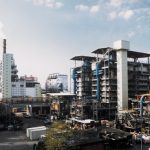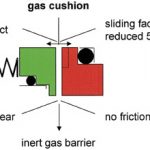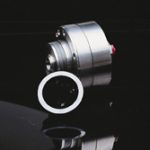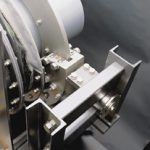For a seal manufacturer, the residue incinera-tion process in a rotary kiln involves applica-tions for which a high technological standard is essential. A rotary kiln sealing system has been specially developed in collaboration with BASF. The outstanding quality and efficiency of the DRO seals are reflected in significantly enhanced running times and virtually mainte-nance-free operation.
Nico Haßmann, Werner Sommer
– high technological standard is essential in a residue incineration plant. On the one hand, the plant uses a variety pumps with corresponding sealing systems for the most diverse media, under conditions which are in some cases subject to change. On the other hand, the rotary kiln has to be sealed off from the plant as far as its rotating movement is concerned on account of the high process temperatures involved and the media which are to be incinerated in the kiln. In addition, the flue gas facilities must be connected together with flexible expansion joints capable of coping with the stress caused by temperature and the respective flue gas composition.
For operation with media containing solid matter
Pump systems which feed liquid residues into rotary kilns are subject to high levels of chemical and abrasive stress.
In particular, the high proportion of solid matter in the media is the cause of a reduced service life for the liquid-lubricated mechanical seals used in the pumps. It is already possible to improve the service life of seals employed in this field of application by using what is known as a stationary mechanical seal with a rotating seat, these being particularly suitable for operation with media containing solid matter. These seals are arranged in an open form towards the product side. In order to prevent any penetration of solid particles into the sealing gap or the accumulation of sediments in the sealing compartment, the product-side seat rotates in the product whilst the springs in the station-ary unit do not come into contact with the latter. Any angular movement of the shaft relative to the housing is compensated by the stationary spring-loaded unit. A stationary spring backing adjusts itself according to the angular error and remains in this position. This type of seal comes in a cartridge design, is double pressure-balanced and internally pressurised.
The service life of a pump system can be further extended by using gas-lubricated mechanical seals.
Gas-lubricated mechanical seals
In its basic form, a gas-lubricated seal resembles a liquid-lubricated, balanced mechanical seal. The seal consists of a spring-loaded seal face and a seat. One ring is stationary, while the other rotates together with the shaft. The seal face and seat are sealed off from the housing and the shaft respectively by secondary seals. Silicon carbide or carbon graphite are the materials from which the seal face and seat are manufactured. The flat faces of the seal face and seat act as the sliding faces. Gas grooves measuring just a few micrometers are machined into one of the two sliding faces. Unlike liquid-lubricated mechanical seals, a gas-lubricated seal uses a stable film of gas between the sliding faces to keep these faces apart, thus enabling them to run on a cushion of gas without coming into contact with each other. The two sliding faces are parted by differential pressure and the rotation of the shaft. The sliding faces are thus wear-free and there is virtually no friction-induced heat. Unlubricated operation with contact would lead to the destruction of the sliding faces. The sealing gap achieved by the sliding faces measures between 2 and 5 µm. The gas medium flows through the sealing gap and is relieved. The small gap width means that leakage rates are kept to a minimum. The two sliding faces must move at a speed of at least 0.5 ms-1 relative to each other in order to ensure that they are separated with zero pressurisation. This separation is additionally supported by a sufficiently high buffer pressure of at least 2 bar above product pressure.
Rotary kiln seals
If, at the end of the residue incineration process, cold air were to be drawn into the kiln – which is operated at negative pressure – it would then be necessary to compensate a fall in the incineration temperature in the afterburner chamber by charging additional fuel. The concomitant rise in the volume of flue gas also has a negative effect on the incineration process. Effectively functioning seals between the rotating kiln and the static elements of the charging facility and the afterburner chamber are therefore of essential importance for ensuring optimum availability and fault-free operation of the incineration kilns. The DRO seal is designed to provide a sealing system which can be fitted to both new kilns and existing plants. A mounting flange is welded onto the rotating cylinder; a metal sealing disc is then screwed to this flange. These parts follow the axial and radial movements of the rotating cylinder. Two axially separated, static housing sections are arranged in compartmental form around the sealing disc and separately supported by centrically mounted rollers. Flexible packing cords are bedded in the housing sections and kept in constant, gap-free contact with the sealing disc by means of compres-sion springs. A flexible expansion joint is fitted between the afterburner chamber and the seal housing to compensate larger axial movements, e.g. during heating up and cooling down of the rotary cylinder. Once installed and optimally adjusted, the sealing system requires virtually no maintenance, and the condition of the wearing parts (packing cords) can be read from special wear indicators, even during operation. Running times of several years with consistently good sealing performance and stability of the incineration progress have already been achieved with this type of seal in many instances.
Incineration kilns fitted with DRO seals
For decades, BASF has been disposing of its production residues in its own plants, and the rotary kiln process is an essential element of the company’s waste disposal concept. The principle task of this system is to utilise for energy purposes all those organic waste substances which are unavoidable and non-materially utilisable. This takes place – with the least possible environmental impact – in a rotary kiln. All non-utilisable waste substances that accumulate during the various production processes, including fluid, pasty and even solid residues, are disposed of in a residue incineration plant of this type.
In collaboration with BASF, this company developed a rotary kiln sealing system especially tailored to meet these requirements and the first line was equipped with it back in 1988. Today, six incineration kilns in Ludwigshafen alone have been successfully fitted with DRO seals, the outstanding quality and efficiency of which are reflected in significantly enhanced running times and virtually maintenance-free operation.
The pump system via which liquid residues are delivered into the rotary kiln was fitted with a type HRC-GS3000N gas-lubricated mechanical seal with a rotating seat. This seal has been in fault-free, discontinuous operation since June 1997 – in short, a
technically sophisticated solution which has considerably increased the service life of the pump system for liquid residues. For the plant’s operator, this not only means shortened downtimes but also a reduction in the outlay for maintenance of the highly stressed pump systems.
Burgmann
Fax: ++49/8171/23 10 95
Further information cpp-205
Unsere Webinar-Empfehlung
Die Websession „Wasserstoff in der Chemie – Anlagen, Komponenten, Dienstleistungen“ (hier als Webcast abrufbar) zeigt technische Lösungen auf, die die Herstellung und Handhabung von Wasserstoff in der chemischen Industrie sicher machen und wirtschaftlich gestalten.
Ob effizienter…
Teilen:














